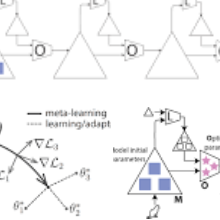Different from large-scale platforms such as Taobao and Amazon, CVR modeling in small-scale recommendation scenarios is more challenging due to the severe Data Distribution Fluctuation (DDF) issue. DDF prevents existing CVR models from being effective since 1) several months of data are needed to train CVR models sufficiently in small scenarios, leading to considerable distribution discrepancy between training and online serving; and 2) e-commerce promotions have significant impacts on small scenarios, leading to distribution uncertainty of the upcoming time period. In this work, we propose a novel CVR method named MetaCVR from a perspective of meta learning to address the DDF issue. Firstly, a base CVR model which consists of a Feature Representation Network (FRN) and output layers is designed and trained sufficiently with samples across months. Then we treat time periods with different data distributions as different occasions and obtain positive and negative prototypes for each occasion using the corresponding samples and the pre-trained FRN. Subsequently, a Distance Metric Network (DMN) is devised to calculate the distance metrics between each sample and all prototypes to facilitate mitigating the distribution uncertainty. At last, we develop an Ensemble Prediction Network (EPN) which incorporates the output of FRN and DMN to make the final CVR prediction. In this stage, we freeze the FRN and train the DMN and EPN with samples from recent time period, therefore effectively easing the distribution discrepancy. To the best of our knowledge, this is the first study of CVR prediction targeting the DDF issue in small-scale recommendation scenarios. Experimental results on real-world datasets validate the superiority of our MetaCVR and online A/B test also shows our model achieves impressive gains of 11.92% on PCVR and 8.64% on GMV.
翻译:与大平台不同,如道保和亚马逊,CVR在小规模建议情景中建模,由于数据分配结构问题严重,CVR在小规模建议情景中建模更具挑战性。DDF防止现有的CVR模型产生效力,因为1,需要几个月的数据在小型假设中充分培训CVR模型,从而导致培训和在线服务之间的分布差异很大;和2,电子商务推广对小型假设产生重大影响,导致即将到来的时段的分布不确定性。在这项工作中,我们从元学习的角度提出名为METCVR的新型CVR方法,以解决DDF问题。首先,一个由功能表示网络(FR)和输出层组成的CVR模型基础模型模型设计并经过几个月的足够培训,以在小型情况下充分培训CVR模型模型模型模型模型模型模型模型;然后,利用相应的样本和经过事先培训的FRNN的DNV模型,对每个样本和所有原型模型之间的距离指标,从而帮助减轻最新阶段的分发不确定性。最后,我们又将数据流算出一个数据周期的DRVRMU值。




